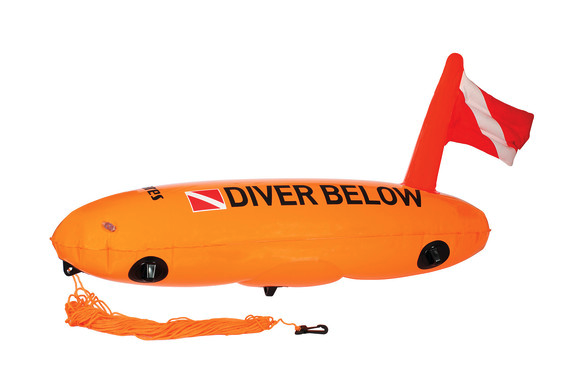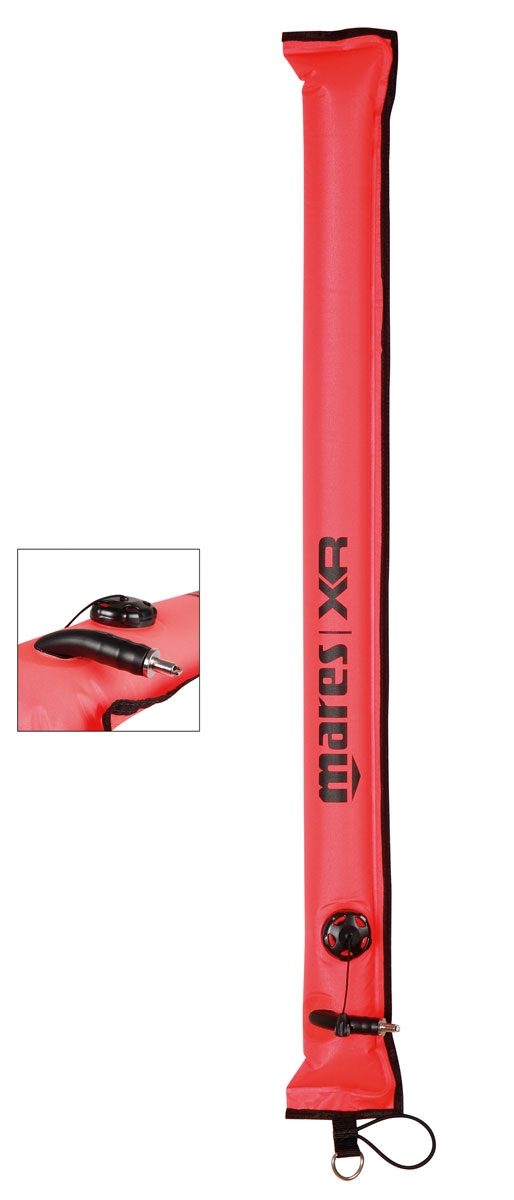
© SMB - Surface Marker Buoy

© DSMB - Delayed Surface Marker Buoy
Surface Marker Buoy 101 - All You Need to Know
May 3, 2021
There are two types of surface marker buoy that are commonly used by divers, surface marker buoys (SMBs) and delayed surface marker buoys (DSMBs). The phrase ‘surface marker buoy’ is often used to describe both types of buoy, but they have very different designs and uses. Both of them are important accessories for scuba diving that help keep you safe in the water. Read on to find out more.
Know your SMBs from your DSMBs? Your FAQs answered:
What is a surface marker buoy?
A surface marker buoy (SMB) is typically a round, highly visible buoy that is inflated and left at the surface prior to a dive. These marker buoys are sealed to prevent them from deflating during the dive and stay at the surface. They are made from a durable buoyant material, and are usually bright red, yellow or orange to make them easy to see on the water surface. Some buoys have writing on them or an attached flag to increase their visibility even more.
What is a surface marker buoy used for?
Divers use a surface marker buoy to make their position in the water clear to people and boat traffic at the surface. They are used when there is no decompression or anchor line available or where strong currents make a drifting ascent preferable. READ MORE: 5 TIPS TO MAKE BOAT DIVING EASIER.
What is a delayed surface marker buoy?
A delayed surface marker buoy (DSMB) is a long, cylindrically shaped tube and is sometimes called a safety sausage. They are carried in a rolled up shape by the diver during the dive and are inflated when needed. Delayed surface marker buoys are made from similar materials as surface marker buoys and are brightly colored to increase visibility.
What is a delayed surface marker buoy used for?
DSMBs are used by divers to signal their position in the water and to communicate with people at the surface near the end of their dive. For example, DSMBs are deployed near the end of a dive to show that divers are going to be ascending soon and where they will be surfacing.
How to use a delayed surface marker buoy.
DSMBs are attached to a line and inflated when needed. DSMBs can be deployed while submerged, so the most important rule when choosing a DSMB is to verify that there is enough line on the reel or spool to enable the buoy to reach the surface. Once deployed, the reel or spool can serve as a depth reference point for team members as they make safety or decompression stops. READ MORE: HOW TO ACHIEVE OPTIMAL TRIM FOR DIVING.
Types of delayed surface marker buoy.
DSMBs typically come in three designs:
Open-ended.
These delayed surface marker buoys are inflated by adding gas from an alternate gas source. The bottom is open, which allows the diver to fill the DSMB, but they must keep some tension on the line to prevent gas from escaping at the surface.
Self-sealing.
Self-sealing delayed surface marker buoys can also be inflated by filling them with gas through an opening at the bottom of the DSMB. As the DSMB ascends, the bottom end seals, preventing gas from escaping.
Sealed.
A sealed delayed surface marker buoy has an inflation valve that can either be orally inflated or fitted to a low-pressure gas supply that is similar to the low-pressure inflator used on buoyancy compensators or dry suits. The diver fills the buoy from a low-pressure inflator; usually from their buoyancy compensator, their wing, their dry suit, or an off-board gas supply. An overpressure valve prevents the expanding gas from tearing the buoy as it ascends to the surface. WATCH: HOW TO ORALLY INFLATE A SEALED DSMB.
Surface marker buoy uses in decompression diving.
Labeling a delayed surface marker buoy helps identify a decompressing diver. A team generally only deploys one DSMB, but additional DSMBs can serve several useful functions, including:
- Carrying slates to the surface.
- Communicating the need for help.
- Signaling a change in diver status.
Some divers use a specific DSMB color to indicate "all is well" or "problem below", but there is not a global consensus on which colors indicate which signal.
How to use a surface marker buoy - learn more.
If you would like to learn more about how to use the different types of surface marker buoys effectively, join an SSI Extended Range program. Our range of programs provide all the training you need to dive deeper, extend your bottom times and enjoy the thrill of exploring deep reefs, wrecks and more. NEW SSI PROGRAM – GO DECOMPRESSION DIVING.